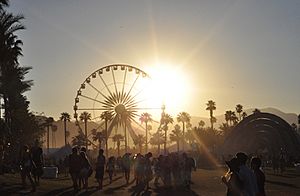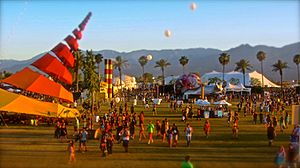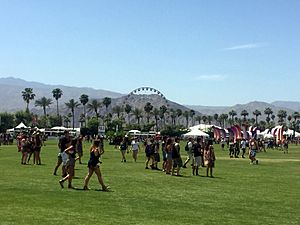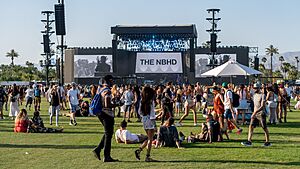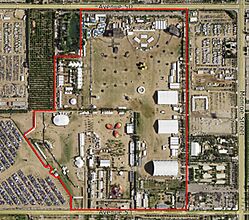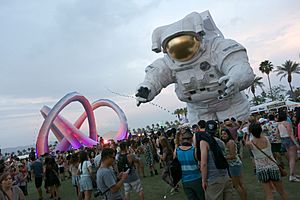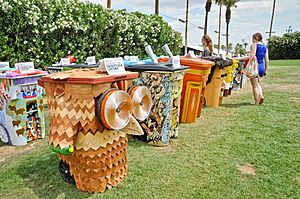Coachella facts for kids
Quick facts for kids Coachella |
|
|---|---|
 |
|
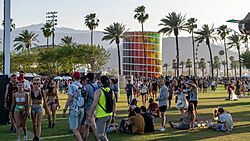
Coachella in 2018
|
|
| Genre | Rock, pop, indie, hip hop, electronic dance music |
| Dates | Two consecutive 3-day weekends in April (currently) |
| Location(s) | Empire Polo Club (Indio, California, U.S.) |
| Coordinates | 33°40′41″N 116°14′02″W / 33.678°N 116.234°W |
| Years active | 1999, 2001–2019, 2022–present |
| Founders | Paul Tollett and Rick Van Santen |
| Attendance | 250,000 (2017, two-weekend total) |
| Capacity | 125,000 |
| Organized by | Goldenvoice |
Coachella is a huge yearly event that brings together music and art. It's officially called the Coachella Valley Music and Arts Festival. People sometimes just call it Coachella Festival.
This amazing festival happens at the Empire Polo Club in Indio, California. This area is part of the Coachella Valley in the Colorado Desert. It was started in 1999 by Paul Tollett and Rick Van Santen. A company called Goldenvoice, which is part of AEG Presents, organizes the festival.
Coachella features many different kinds of music. You can hear rock, pop, indie, hip hop, and electronic dance music. Besides music, there are also cool art installations and sculptures to see. Many stages across the festival grounds play live music all the time.
The idea for Coachella started with a Pearl Jam concert in 1993. That show proved the Empire Polo Club was a great place for big events. The first Coachella Festival happened over two days in October 1999. After not having a festival in 2000, Coachella came back every year starting in April 2001. It began as a one-day event.
In 2002, it became a two-day festival again. Coachella grew to three days in 2007. Then, in 2012, it expanded to two weekends. Now, it takes place on two weekends in April, with the same performers each weekend. In 2003, people could start camping at the festival. Coachella was not held in 2020 and 2021 because of the COVID-19 pandemic.
Coachella shows off popular and new musical artists. It also brings back reunited groups. It is one of the biggest, most famous, and most successful music festivals in the United States and the world. From 2013 to 2015, Coachella broke records for how many people attended and how much money it made. In 2017, 250,000 people went, and it made $114.6 million. Because Coachella was so successful, Goldenvoice started other music festivals at the same location. One of these is the Stagecoach country music festival, which began in 2007.
Contents
The Story of Coachella
How Coachella Began
On November 5, 1993, the rock band Pearl Jam played a concert for almost 25,000 fans. This concert was at the Empire Polo Club in Indio, California. The band chose this spot because they had a disagreement with Ticketmaster. This show proved that the polo club was perfect for large events. Paul Tollett, whose company Goldenvoice booked Pearl Jam, said this concert planted the idea for a music festival there.
Around 1997, Goldenvoice was having trouble booking concerts. They couldn't offer as much money as bigger companies. Tollett realized a music festival might be a good idea. He wanted to book cool artists who weren't necessarily super famous. He thought putting many of them together would attract a lot of people.
Tollett visited the 1997 Glastonbury Festival in England. He handed out flyers with pictures of the sunny Empire Polo Club. People at Glastonbury, which is often muddy, thought it was funny.
After looking at many places, Tollett and Rick Van Santen returned to the Empire Polo Club in 1998. They were impressed and decided to hold their festival there. They hoped to start in 1998 but had to wait until 1999. On July 16, 1999, Indio City Council approved the festival. They even gave $90,000 for things like traffic control.
Coachella was officially announced on July 28, 1999, with 40 acts. Tickets went on sale on August 7. This announcement came just one week after Woodstock '99, which had many problems. Because of this, Goldenvoice's insurance costs went up a lot. Coachella organizers wanted to offer a "high-comfort festival experience." They advertised free water, plenty of restrooms, and misting tents.
Early Festivals: 1999, 2001–2002
The first Coachella Festival happened on October 9–10, 1999. The main performers were Beck, Tool, and Rage Against the Machine. Other bands included the Chemical Brothers and Morrissey. Organizers wanted to create a festival like those in Europe, with smaller crowds and a great setting. By choosing artists based on their art, not just radio hits, Coachella became known as "the anti-Woodstock."
Tickets cost $50 per day. About 17,000 tickets sold for the first day and 20,000 for the second. This was less than their goal of 70,000 people. The festival went smoothly, and the crowd was well-behaved. The biggest challenges were temperatures over 100°F and choosing which of the 80-plus acts to see. Critics loved the festival. However, Goldenvoice lost $850,000, which made it hard for the company to survive.
Goldenvoice planned to have Coachella again in October 2000 but canceled it. Tollett said there were too many music festivals in Southern California. Instead, Goldenvoice held an electronic dance music festival called Nocturnal Wonderland at the same location.
Coachella returned in April 2001 to avoid the heat. Ticket prices went up to $65. It was hard to book bands, so the festival was only one day. Perry Farrell agreed to bring his reunited band Jane's Addiction to perform. In March 2001, Tollett sold Goldenvoice to Anschutz Entertainment Group (AEG) for $7 million. AEG wanted Tollett to keep running Coachella, even if it lost money at first. The 2001 festival went well, with 32,000 people attending.
For its third year, Coachella went back to being a two-day event on April 27–28, 2002. About 60 artists performed, including headliners Björk and Oasis. Queens of the Stone Age became the first local band to play. The festival made some changes, like using one less tent and removing a fence to make the area feel more open. Over 55,000 people attended, and the festival almost made a profit for the first time.
Growing Popularity: 2003–2005
The 2003 festival was on April 26–27. It featured 82 acts, with Red Hot Chili Peppers and Beastie Boys as headliners. For the first time, people could camp overnight at the festival. The festival drew 60,000 people, which was the biggest crowd yet. Coachella started to become well-known around the world.

In late 2003, Rick Van Santen passed away. In 2004, Tollett sold half of Coachella to AEG. The 2004 festival had over 80 acts, with Radiohead and the Cure as headliners. It was Coachella's first time selling out, with 110,000 people attending over two days. People came from all 50 US states. Critics praised the event, calling it the best music festival in the country. Tollett said 2004 was a turning point for Coachella, thanks to booking Radiohead.
The 2005 festival was on April 30 to May 1. It featured Coldplay and Nine Inch Nails as headliners. About 50,000 people attended each day.
Big Names and New Records: 2006–2008

The 2006 festival had Depeche Mode and Tool as headliners. Two very popular performances were Madonna and Daft Punk. Daft Punk's show, with a pyramid-shaped stage, is often called one of the most memorable in Coachella's history. About 120,000 people attended over two days, and Goldenvoice made $9 million.
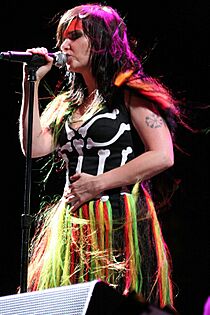
In 2007, Goldenvoice started the Stagecoach Festival, a country music festival at the same location. This new event helped secure a long-term lease for Coachella. Also in 2007, Coachella was permanently extended to three days. The headliners were Red Hot Chili Peppers, the reunited Rage Against the Machine, and Björk. All of them had headlined before. The festival had a record 186,000 attendees and made $16.3 million.
In 2008, Coachella did not sell out for the first time since 2003. The headliners were Prince, Roger Waters, and Jack Johnson. The festival had 151,666 attendees and made $13.8 million. However, it lost money because tickets didn't sell out and the booking fees for Prince and Roger Waters were very high.
Changes and Challenges: 2009–2011
The 2009 festival happened a week earlier, from April 17–19. Headliners included Paul McCartney, The Killers, and The Cure. Paul McCartney played past the festival's strict curfew. The Cure's performance was cut short when the power was turned off after they also went over their curfew. The festival had 152,962 attendees and made over $15 million.
In 2010, organizers only sold three-day tickets, not single-day ones. This caused mixed reactions. Headliners were Jay-Z, Muse, and Gorillaz. Even with concerns about the economy, Coachella had 75,000 spectators each day, totaling 225,000. This broke previous records. Some fans broke through fences, leading to worries about too many people. The festival made $21.7 million. Some European acts had to cancel because of a volcano eruption in Iceland.
Before the 2011 festival, Goldenvoice made improvements to the area. They added a lane to Avenue 50, cleared more space, and moved horse stables. Lighting and security were also improved. The headliners were Kings of Leon, Arcade Fire, Kanye West, and The Strokes. The 2011 festival made almost $25 million from 75,000 attendees each day.
Two Weekends and Holograms: 2012–2014
On May 31, 2011, Goldenvoice announced that Coachella would expand to two weekends starting in 2012. Both weekends would have the same lineup. Tollett explained that demand for tickets was very high, and he didn't want to overcrowd the venue. Rolling Stone called it a "very risky move," but tickets for 2012 sold out in less than three hours.
The 2012 festival featured the Black Keys, Radiohead, and a joint performance by Dr. Dre and Snoop Dogg. During Dr. Dre and Snoop Dogg's show, a projection of the late rapper Tupac Shakur appeared on stage. This projection performed songs like "Hail Mary". People called it a "hologram," but it was actually a special projection system. The 2012 festival made over $47 million from 158,387 attendees across both weekends.
Before the 2013 festival, Goldenvoice made a deal with Indio to keep Coachella and Stagecoach there until 2030. The city's share of ticket revenue increased. Headlining the 2013 festival were Blur, The Stone Roses, Phoenix, and Red Hot Chili Peppers. General admission tickets cost $349. The festival made $67.2 million and had 180,000 attendees, making it the top music festival in the world. In July 2013, Goldenvoice bought 280 acres of land around the Empire Polo Club. This land is used for more parking and festival space.
The 2014 festival, held on April 11–13 and April 18–20, featured 184 artists. A reunited Outkast headlined Friday, Muse on Saturday, and Arcade Fire on Sunday. General admission tickets sold out in less than 20 minutes. That year's festival had 96,500 daily attendees and made a record $78.332 million. For the fourth year in a row, Coachella was named the Top Festival at the Billboard Touring Awards.
Continued Success: 2015–2017
The 2015 festival, held on April 10–12 and 17–19, featured AC/DC, Jack White, and Drake as headliners. Madonna made a surprise appearance during Drake's performance. General admission tickets sold out in under 20 minutes again. The event set new records for tickets sold (198,000) and total money made ($84,264,264). Coachella won Pollstar's award for Major Music Festival of the Year.
In March 2016, Indio City Council allowed Coachella to increase its attendance limit from 99,000 to 125,000. Goldenvoice also made the venue bigger. The 2016 festival was on April 15–17 and 22–24. It was headlined by reunited LCD Soundsystem, reunited Guns N' Roses, and Calvin Harris. Ice Cube's performance included a reunion of N.W.A.. The festival sold 198,000 tickets and made $94.2 million.
The 2017 Coachella festival took place from April 14–16 and April 21–23. It featured Radiohead, Lady Gaga, and Kendrick Lamar as headliners. Beyoncé was supposed to headline but had to cancel because she was pregnant. She announced she would headline in 2018 instead. Tickets sold out in a few hours. The 2017 festival had 250,000 attendees and made $114.6 million. This was the first time a festival made over $100 million. Scenes for the movie A Star Is Born, starring Lady Gaga and Bradley Cooper, were filmed at the festival.
Recent Festivals: 2018–Present
The 2018 festival featured the Weeknd, Beyoncé, and Eminem as headliners. Beyoncé became the first African-American woman to headline the festival. Her performances celebrated the culture of historically Black colleges and universities. She had a marching band and dancers. Her sister Solange Knowles and former Destiny's Child members Kelly Rowland and Michelle Williams also joined her on stage. Her performances were highly praised and called historic. Her show had 458,000 viewers on YouTube at the same time, making it the most-watched performance at the festival. The whole festival had 41 million total viewers online. Her performances were made into a concert film, Homecoming: A Film by Beyoncé, and a live album.
In response to concerns about safety at the 2018 festival, Goldenvoice started a new program in 2019 called "Every One." This program provides resources and rules to help prevent bad behavior and make the festival safer. "Safety ambassadors" were available to help attendees.
Coachella celebrated its 20th anniversary in 2019. It took place from April 12–14 and 19–21. The headliners were Childish Gambino, Tame Impala, and Ariana Grande. At 25 years old, Ariana Grande was the youngest artist to headline. Kanye West held a special "Sunday Service" performance on Easter at the campgrounds. The first weekend had some sound problems during performances.
The 2020 festival was planned for April but was first postponed, then canceled due to the COVID-19 pandemic. The 2021 festival was also canceled because of pandemic rules.
Coachella returned in 2022 on April 15–17 and April 22–24. The headliners were Harry Styles, Billie Eilish, and a joint performance by Swedish House Mafia and The Weeknd. Kanye West had been scheduled but withdrew shortly before the festival.
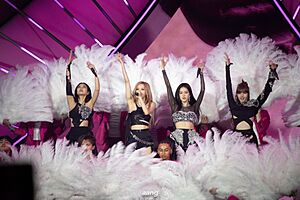
The 2023 Coachella festival, from April 14–16 and April 21–23, also had last-minute changes. The headliners were Bad Bunny, Blackpink, and Frank Ocean. Bad Bunny was the first Latin headliner, and Blackpink was the first Asian headliner. Frank Ocean had some issues with his performance on the first weekend and then withdrew from the second weekend. Blink-182 was added to fill the Sunday night spot for the second weekend.
The 2024 festival featured headliners Lana Del Rey, Tyler, the Creator, and Doja Cat. It also had a reunion by No Doubt. It took longer for tickets to sell out that year. The movie The Idea of You, released in 2024, prominently features Coachella.
The 2025 festival featured Lady Gaga, Green Day, Travis Scott, and Post Malone as headliners. Lady Gaga became the second woman to headline Coachella twice. Her show was highly praised. Green Day and Post Malone headlined Coachella for the first time. On April 12, 2025, the Los Angeles Philharmonic became the first major orchestra to perform at Coachella.
Where Coachella Happens
Layout and performance areas for 2016 festival
|
||||||||||||||||||||
Coachella is held in Indio, California. This city is in the Coachella Valley within the Colorado Desert. Temperatures during the festival have ranged from 43 °F (6 °C) to 106 °F (41 °C). The festival takes place at the 78-acre Empire Polo Club. When you include parking and camping areas, the festival covers about 642 acres. The site is about 125 miles (200 km) east of Los Angeles.
During the festival, many stages play live music. There are two outdoor stages and several tents named after deserts. The main stages used since Coachella started are:
- Coachella Stage – This is the main stage where the biggest acts perform. It draws the largest crowds.
- Outdoor Theatre – A smaller outdoor stage right next to the Coachella Stage.
- Mojave – A mid-size tent named after the Mojave Desert. It hosts many different types of artists. It has been moved and made bigger over the years.
- Gobi – Another mid-size tent, named after the Gobi Desert. It also hosts various artists. Like the Mojave, it was moved in 2017.
- Sahara – A large, hangar-like tent named after the Sahara Desert. This tent usually features the top electronic dance music acts. It was expanded in 2013 and moved in 2018 to a new spot with more shade.
Over time, more performance areas have been added:
- Yuma – A small indoor tent added in 2013. It mainly features new DJs. It's designed to be a calm space for thoughtful sounds.
- Sonora – A small indoor tent added in 2017. It hosts punk rock and Latin acts.
- Heineken House – A small venue added in 2014. It's known for "legendary musical performances." In 2019, it was redesigned to be more open.
- Despacio – A small indoor tent used in 2016. It played "slow-simmering disco and vintage club music" on vinyl. It had a powerful sound system and air conditioning.
- Antarctic – An indoor dome added in 2017. It shows 360-degree immersive videos. It's 120 feet wide and has air conditioning.
- Quasar – An outdoor stage added in 2024 for long DJ sets.
Art at the Festival
Coachella is not just about music; it's also a place to see amazing visual arts. This includes installation art and sculptures. Many of the art pieces are interactive, meaning you can engage with them. Over the years, the art has become bigger and more creative. Paul Clemente, Coachella's art director since 2009, says they always try to make the art better for the fans.
In Coachella's early years, much of the art came from the Burning Man festival. This was because of smaller budgets. Between 2010 and 2015, Goldenvoice started paying artists to create new pieces just for Coachella. Artists get only 10 days before the festival to set up their art. Because it's so expensive to put them together again, only about half of the pieces appear outside of Coachella. Cynthia Washburn from the art group Poetic Kinetics says Coachella is becoming as popular for artists as it is for musicians. In 2013, Clemente looked at about 300 art ideas. Poetic Kinetics has created several giant moving art pieces for Coachella. These include a snail in 2013, an astronaut in 2014, and a caterpillar that turned into a butterfly in 2015.
Some of the artworks have been shown at Art Basel, a famous art show. Some visual artists, like Hotshot the Robot and The Do LaB, have appeared for many years. Poster artist Emek has made special posters every year since 2007.
How Coachella is Organized
Indio, the city that hosts Coachella and the Stagecoach Festival, provides many services. These include police, fire protection, medical services, and city staff. In 2012, these services cost $2.77 million for the three festival weekends. The Indio police department works with almost 12 other agencies to keep everyone safe.
To avoid disturbing local residents, there is a curfew for music performances. Since 2010, music must stop by 1 a.m. on Friday and Saturday nights, and by midnight on Sunday nights. If Goldenvoice goes over the curfew, they have to pay a fine. These fines help the city's General Fund, which pays for city services like police and fire departments.
Caring for the Environment
Coachella organizers work with an organization called Global Inheritance to be more environmentally friendly. One project is "TRASHed :: Art of Recycling." Artists design and decorate recycling bins that are placed around the festival. Another program is "Carpoolchella." Since 2007, groups of four or more people who carpool to the festival can enter a drawing to win VIP tickets for life. By 2014, 140,000 people had participated.
In 2007, Coachella started a 10-for-1 recycling program. If you collect ten empty water bottles, you get a free full one. In 2009, the festival introduced $10 refillable water bottles. You can refill these at water stations. Other programs include solar powered DJ booths and seesaws that charge mobile phones.
About 600 staff members collect trash during the festival. They sort materials on site before sending them to recycling centers. Goldenvoice aims to recycle or compost 90 percent of its waste. In 2013, they diverted over 577 million pounds of materials.
Camping at Coachella
In 2003, Coachella started allowing tent camping. The campground is on a polo field next to the festival grounds. It has its own entrance. In 2010, new features were added, like being able to re-enter the festival from the campsite. You could also park next to your tent. Over 17,000 people camped at the 2010 festival. In 2012, the campsite had recycling, a store, showers, phone charging stations, and free WiFi.
Booking the Artists
Paul Tollett starts booking artists for each festival as early as August of the previous year. He looks at artists booked by Goldenvoice for their other 1,800 shows each year. He also uses ticket sales data to see which artists are popular. The booking process takes about six months.
Artists playing Coachella usually get paid at least $15,000. Top headliners in 2010 were expected to get over $1 million. In 2017, headliners reportedly received $3–4 million. Beyoncé in 2018 and Ariana Grande in 2019 reportedly earned $8 million each.
Goldenvoice uses "radius clauses" in their contracts. These rules can stop artists from performing in the area around Coachella for a certain time before and after the festival. This helps make Coachella a unique event. Goldenvoice does allow some Coachella artists to play smaller shows in Southern California before or between weekends. These are called "Localchella" shows.
Goldenvoice tries to release the lineup poster around New Year's Day. This makes Coachella the first major festival to announce its lineup each year. This gives them an advantage over other festivals. The size of an artist's name on the poster is a big deal. It can affect how much money they get for future shows. Tollett says they have many arguments over font sizes.
Promoting the Festival
At first, organizers didn't want many sponsors. They felt it would take away from the "purity" of the event. However, they have become more open to sponsorships over the years. The brewing company Heineken N.V. has sponsored Coachella since 2002. They have a "Heineken House" at the festival where people can drink beer.
Clothing company H&M had a sponsored tent in 2015. They sold items from their "H&M Loves Coachella" clothing line. Technology company HP has sponsored the Antarctic dome since 2017. They also have a promotional tent where attendees can design bandanas and interact with cool tech. Tollett still doesn't want sponsors' logos on the main stages. He believes it should be just the audience and the band during a performance.
Since 2011, YouTube has live streamed performances from Coachella. In 2019, YouTube streamed both weekends of the festival for the first time. The 2023 streaming agreement with YouTube was renewed through 2026. Now, performances from all six stages are streamed.
In 2016, organizers partnered with Vantage.tv to offer virtual reality (VR) content. Ticket holders received a cardboard VR viewer to use with the Coachella VR mobile app. This allowed them to see 360-degree photos and virtual tours. YouTube also live streamed performances in 360 degrees for VR headsets.
Coachella's success has led its organizers to work with other American music festivals. In 2014, Goldenvoice partnered with Red Frog Events to help promote their Firefly Music Festival. In 2015, they made a similar agreement with the organizers of the Hangout Music Festival.
Protecting the Coachella Name
Goldenvoice works hard to protect the Coachella brand. They have filed lawsuits against groups that tried to use the Coachella name or names ending in "chella." This includes music festivals, film festivals, and even a grocery store event. Goldenvoice's lawyers say this is how they protect their trademark. Even though the town of Coachella, California existed before the festival, the festival's success has made the name famous.
In December 2021, Coachella won a court order against Live Nation's "Coachella Day One 22" festival. A judge ruled that Live Nation was likely using the trademark illegally by selling tickets to an event nearby.
Coachella's Impact
In 2015, Coachella was ranked the second most in-demand concert ticket in the world. Many people see Coachella as a trendsetter in music and fashion. Singer Katy Perry said, "The lineup always introduces the best of the year for the rest of the year."
Coachella is known for the unique clothes people wear. This often includes bright colors and different styles. Some people have criticized certain outfits, like non-Native Americans wearing Native American-inspired headdresses, as being disrespectful.
A 2012 study found that Coachella brought $254.4 million to the desert region that year. Indio, the host city, received $89.2 million in spending and $1.4 million in tax money. The Stagecoach Festival, also held by Goldenvoice, has grown quickly. Together, the two festivals were estimated to have a global impact of $704.75 million in 2016. The city of Indio was expected to gain $3.18 million in ticket taxes from both festivals in 2016.
Coachella's success led Goldenvoice to hold more music festivals at the Empire Polo Club. They started Stagecoach in 2007. In 2011, they held the Big 4 festival, featuring famous thrash metal bands like Metallica. In 2016, Goldenvoice put on Desert Trip, which featured older rock legends like the Rolling Stones and Paul McCartney.
Festival Summary by Year
| Edition | Year | Dates | Headliners | Gross revenues |
Attendance or sales | Avg. daily attendance/sales |
|---|---|---|---|---|---|---|
| 1st | 1999 | October 9–10 | N/A | 37,000 (sales) | 18,500 | |
| 2nd | 2001 | April 28 | Jane's Addiction | N/A | 32,000 (attendance) | 32,000 |
| 3rd | 2002 | April 27–28 | N/A | 55,000 (attendance) | 27,500 | |
| 4th | 2003 | April 26–27 | N/A | 60,000 (attendance) | 30,000 | |
| 5th | 2004 | May 1–2 | N/A | 110,000 (attendance) | 55,000 | |
| 6th | 2005 | April 30 – May 1 | N/A | 100,000 (attendance) | 50,000 | |
| 7th | 2006 | April 29–30 |
|
$9 million | 120,000 (attendance) | 60,000 |
| 8th | 2007 | April 27–29 | $16.3 million | 187,000 (attendance) | 62,333 | |
| 9th | 2008 | April 25–27 |
|
$13.8 million | 152,000 (attendance) | 51,000 |
| 10th | 2009 | April 17–19 |
|
$15.3 million | 153,000 (attendance) | 51,000 |
| 11th | 2010 | April 16–18 | $21.7 million | 225,000 (attendance, agg.) | 75,000 | |
| 12th | 2011 | April 15–17 | $24.9 million | 225,000 (attendance, agg.) | 75,000 | |
| 13th | 2012 |
|
|
$47.3 million | 158,000 (sales) | 79,000 |
| 14th | 2013 |
|
|
$67.2 million | 180,000 (attendance) | 90,000 |
| 15th | 2014 |
|
|
$78.3 million | 579,000 (attendance, agg.) | 96,500 |
| 16th | 2015 |
|
$84.2 million | 198,000 (sales) | 99,000 | |
| 17th | 2016 |
|
|
$94.2 million | 198,000 (sales) | 99,000 |
| 18th | 2017 |
|
$114.6 million | 250,000 (attendance) | 125,000 | |
| 19th | 2018 |
|
N/A | N/A | N/A | |
| 20th | 2019 |
|
|
N/A | N/A | N/A |
| — | 2020 | Scheduled:
Rescheduled:
|
Scheduled: | Cancelled due to the COVID-19 pandemic. | ||
| — | 2021 | Scheduled:
|
N/A | Cancelled due to the COVID-19 pandemic. | ||
| 21st | 2022 |
|
|
N/A | N/A | N/A |
| 22nd | 2023 |
|
|
N/A | N/A | N/A |
| 23rd | 2024 |
|
N/A | N/A | N/A | |
| 24th | 2025 |
|
N/A | N/A | N/A | |
Awards Coachella Has Won
Coachella has won many awards over the years, showing how popular and successful it is.
Billboard Touring Awards
| Year | Category | Work | Result | Ref. |
|---|---|---|---|---|
| 2011 | Top Festival | Coachella Valley Music and Arts Festival | Won | |
| 2012 | Won | |||
| Top Boxscore | Coachella Valley Music and Arts Festival, April 13–22 | Won | ||
| 2013 | Top Festival | Coachella Valley Music and Arts Festival | Won | |
| 2014 | Won | |||
| 2015 | Won | |||
| 2016 | Won | |||
| 2017 | Won |
International Dance Music Awards
| Year | Category | Work | Result | Ref. |
|---|---|---|---|---|
| 2008 | Best Music Event | Coachella – Indio, California | Nominated | |
| 2009 | Nominated | |||
| 2010 | Nominated | |||
| 2011 | Nominated | |||
| 2012 | Nominated | |||
| 2013 | Nominated | |||
| 2014 | Nominated | |||
| 2015 | Nominated | |||
| 2016 | Nominated | |||
| 2020 | Best Festival | Coachella | Nominated |
Pollstar Awards
| Year | Category | Result | Ref. |
|---|---|---|---|
| 1999 | Music Festival of the Year | Won | |
| 2002 | Nominated | ||
| 2003 | Won | ||
| 2004 | Won | ||
| 2005 | Music Festival of the Year (non-touring) | Nominated | |
| 2006 | Music Festival of the Year | Won | |
| 2007 | Won | ||
| 2008 | Music Festival of the Year (non-touring) | Won | |
| 2009 | Won | ||
| 2010 | Won | ||
| 2011 | Major Music Festival of the Year (non-touring) | Won | |
| 2012 | Major Music Festival of the Year | Won | |
| 2013 | Won | ||
| 2014 | Nominated | ||
| 2015 | Won | ||
| 2016 | Nominated | ||
| 2017 | Won | ||
| 2018 | Music Festival of the Year (over 30K attendance) | Won | |
| 2019 | Music Festival of the Year (US Only; over 30K attendance) | Nominated | |
| 2022 | Music Festival of the Year (Global; over 30K attendance) | Nominated | |
| 2024 | Music Festival of the Year (Global: over 30K attendance) | Nominated |
See also
 In Spanish: Festival de Música y Artes de Coachella Valley para niños
In Spanish: Festival de Música y Artes de Coachella Valley para niños


